Do you want to know how to determine or tell the age of a German Shepherd puppy or an adult dog? You’re in the right place.
In this tutorial, we will guide you on how you can determine the age of a German Shepherd (1) by examining its teeth, height, body length, & weight (2) by looking at physical appearance (3) observing its behavior.
Determining the age of German Shepherd puppy or a dog is important primarily for four reasons (1) When you go to buy a German Shepherd from someone or a breeder, they might tell you the wrong age just to sell (2) To create a proper healthy diet according to its age (3) To provide the right training in different age stages (4) To give the essential puppy and dog vaccines according to its age. | Also Read: A Guide for Raising German Shepherd Puppy at Home.
RELATED
- How to Know German Shepherd Puppy is Male or Female | Gender
- How to Spot a Fake German Shepherd Puppy | 10 Tips
- How to Identify the Purity of German Shepherd Puppy | 5 Ways
- Male or Female German Shepherd: Which One is Better?
- How to Determine Most Desirable Traits in German Shepherd?
- At What Age German Shepherds Slow Down?
- 8 Ways to Identify Long Coat German Shepherd Puppy
Following topics will be covered in this post:
- How to Determine the Age of a German Shepherd Puppy By Examining Its Teeth
- How to Determine the Age of a German Shepherd Puppy By Measuring Its Height, Length, & Weight
- How to Determine the Age of a German Shepherd Puppy From Its Physical Appearance
- How to Determine the Age of a German Shepherd Puppy By Observing Its Behavior
|| DON’T MISS! Today’s Deals on Chewy – Pet Foods, Products, Supplies, Toys, and more. Additionally, visit our Etsy & Online Store for German Shepherd merchandise.
01. How to Determine the Age of a German Shepherd Puppy By Examining Its Teeth
One of the most authentic and accurate ways of determining the age of a German Shepherd puppy or any puppy is by examining its teeth.
So before we guide you on how to determine the age of German Shepherd puppy by examining its teeth, it is important to understand the dental anatomy of dogs.
Dental Anatomy of Dogs
There are two sets of dog teeth i.e. Deciduous Teeth and Permanent Teeth, and 4 types, that include Incisors, Canines, Premolars, and Molars. They are explained and illustrated below.
Deciduous dog teeth, commonly known as puppy teeth or milk teeth, play a critical role in the early development of dogs. These teeth begin to erupt when puppies are about 2 to 4 weeks old. In total, a puppy will have 28 deciduous teeth, which are sharper and smaller than their permanent teeth.

These teeth include incisors, canines, and premolars, all designed to help the puppy chew soft food and explore its environment. However, they are not meant to last a lifetime. By the age of 3 to 7 months, these milk teeth will start to fall out, making way for 42 permanent teeth in most dog breeds.
Related: German Shepherd Teeth Problems: Causes, Prevention, Treatment
The permanent teeth include incisors, canines, premolars, and molars. Remember that the Molars are not included in the Deciduous teeth because they erupt with the permanent teeth.
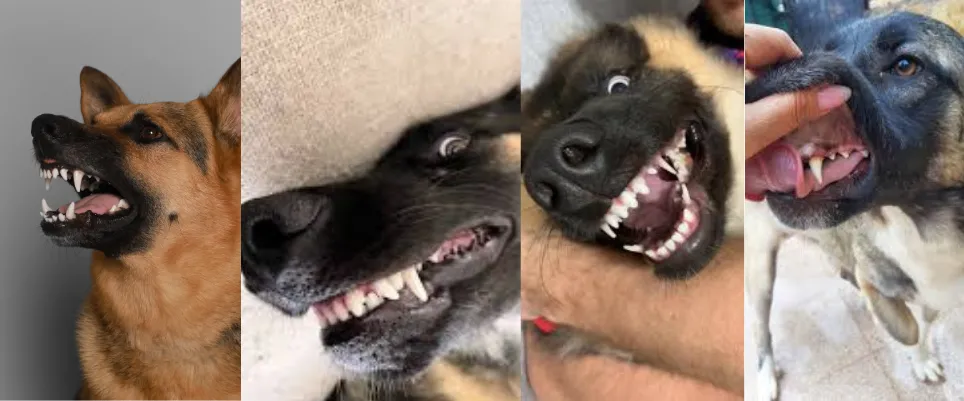
- Incisors: Located at the front of the mouth, are the smallest teeth. They are primarily used for nibbling and scraping meat off bones. There are total 12 Incisors, 6 on the top and 6 on the bottom jaw. The 2 Incisors next to the Canines are slightly bigger than the middle Incisors, as you can see below.
- Canines: Also referred to as fangs, are sharp, pointed teeth situated next to the incisors. These are used for tearing meat and are vital in a dog’s grasp and defense mechanisms. There are total 4 Canines, 2 on both the bottom and upper jaw.
- Premolars: Following the Canines, Premolars appear, which are essential for shearing and breaking down food into smaller, more digestible pieces. Dogs have 4 premolars on the top and bottom of both sides of their mouth, making a total of 16.
- Molars: Located at the back of the mouth, which are used for grinding and crushing food, especially harder items, aiding in the digestion process. There are 4 molars on the top of dog’s mouth and 6 on the bottom.
At your left side, the 12 teeth highlighted with blue border are Incisors. The 4 teeth pointed individually with red arrows are Canines. At your right side, the teeth highlighted with yellow border are Premolars and Molars.

This is the diagram of a dental anatomy of an adult dog. You can clearly see each teeth type and their quantity on both the upper jaw and the lower jaw.

How to Determine the Age of a Puppy By Examining Its Teeth
We hope that you have thoroughly read the above section and must have a good understanding about different types of dog teeth. Now in this section, we will guide you on how to determine the age of a German Shepherd puppy or any puppy by examining its teeth.
Initially, at about 2 to 4 weeks old, a puppy’s deciduous or baby teeth start to appear, with the incisors coming in first, followed by the canines and then the premolars.

By 6 to 8 weeks, a German Shepherd puppy should have all 28 of its baby teeth. Examining these baby teeth, you can generally tell if a puppy is under 2 months old.

As the puppy grows older, the next milestone comes at around 12 to 16 weeks of age when it begins to lose its baby teeth, and the permanent teeth start to emerge. The first permanent teeth to appear are usually the incisors, which are followed closely by the development of new, permanent premolars. At this stage, if you notice a mix of small, slightly worn baby teeth and larger cleaner permanent teeth, it’s a good indication that a puppy is between 3 to 5 months old.

By the time the German Shepherd is around 6 month old, most, if not all, of its 42 adult teeth should be present. This full set includes incisors, canines, premolars, and molars, which are the last to develop. Noticing the molars is significant because they don’t have baby predecessors and only come in once as permanent teeth, usually by 5 to 7 months of age. If you see these teeth, you can be fairly certain of the age bracket.
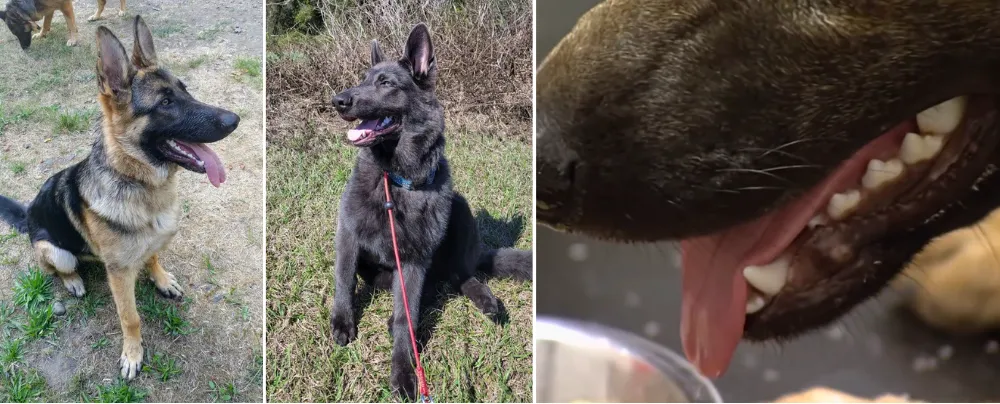
This is the close-up view of jaw of an 8 month old German Shepherd puppy. You can see that all of its 42 permanent (adult) teeth have been erupted i.e. 12 Incisors, 4 Canines, 16 Premolars, and 10 Molars.

If all teeth are adult and completely white the puppy is 1 year old. The wear and tartar build-up on the dog teeth can give you the clues about the dog’s age as it advances beyond the puppy stage.
Yellow staining on the dog’s canines and the molars typically begins to occur between 1 and a half to 3 years of age. The tartar typically begins to build up between 2 to 3 years. So if there is some staining you are talking about 1 to 2 years of age. If there is a mild tartar the dog is 3 to 5 years of age. Moderate tartar on the molars and canines tells you that dog is 5 to 7 or 8 years of age. The severe tartar means the dog is most probably 10 years old or more.

This approach might not be 100% correct, however, for young puppies, the sequence and timing of tooth eruption are your most reliable guides, as illustrated in the above steps.
02. How to Determine the Age of a German Shepherd Puppy by Measuring its Height, Length, & Weight,
In this section, we will guide you on how to determine the age of a German Shepherd puppy by measuring its height, body length, and weight. We have also created a German Shepherd puppy growth chart that shows its height, weight, and body length according to age.
Generally, German Shepherds undergo rapid growth phases until they are about 6 to 12 months old. During this period, puppies can increase significantly in both weight and height, with males typically becoming larger than females.
After reaching one year, a German Shepherd’s growth in height will slow significantly, although they may continue to fill out in muscle and girth until about 18-24 months of age.
How to Measure the Height & Body Length of a German Shepherd
We have created a separate step-by-step tutorial on how to measure the height and body length of a German Shepherd. Go through this tutorial to thoroughly learn the procedure.
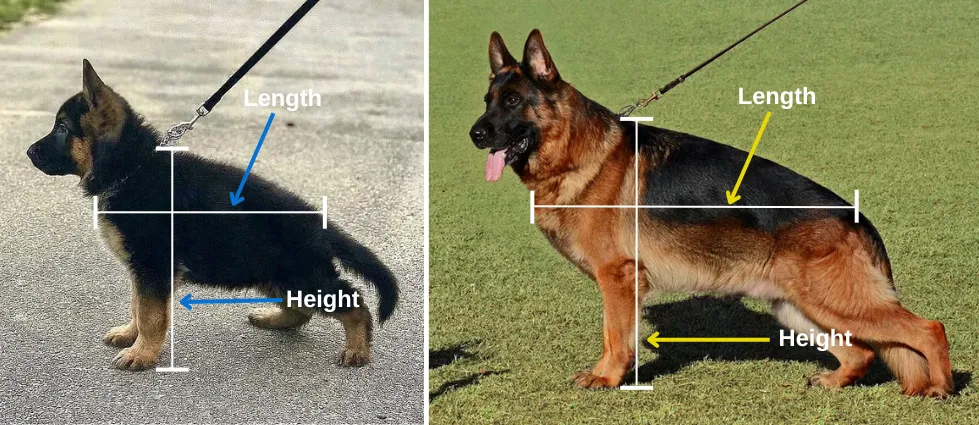
How to Measure The Weight of a German Shepherd
A fully grown male German Shepherd weighs approximately 79 to 88 pounds, while females typically weigh between 66 to 70 pounds.
To measure the weight of a German Shepherd puppy or an adult dog place it on the Dog Weight Scale and record the readings.
Below are some of the Digital Pet Scales that you can use to measure the weight of a dog.
- For Puppies: Brecknell MS-16, Brecknell MS20S, Brecknell MS15.
- For Adult Dogs: Redmon Digital Field.

German Shepherd Puppy Growth Chart
Below are the two charts that show the Height, Weight, and Body Length of a male and female German Shepherd in different age stages. You can easily determine the age of a German Shepherd by matching your measurements with the measurements given in these charts.
The “–” symbol reads as to. For example 3-4 means 3 to 4 inches.
Male German Shepherd Puppy Growth Chart
| Age | Height (Inches) | Weight (lbs) | Length (Inches) |
|---|---|---|---|
| Newborn | 3-4 | 0.5-1 | 4.92-6.56 |
| 1 month | 4-6 | 5.5-9 | 6.56-9.84 |
| 2 months | 7-9 | 16-20 | 11.48-14.76 |
| 3 months | 9-11 | 22-30 | 14.76-18.04 |
| 4 months | 11-14 | 35-40 | 18.04-22.96 |
| 5 months | 14-16 | 40-49 | 22.96-26.24 |
| 6 months | 16-18 | 49-57 | 26.24-29.52 |
| 7 months | 19-20 | 57-62 | 29.52-32.8 |
| 8 months | 20-22 | 62-66 | 32.8-36.08 |
| 9 months | 21-23 | 64-71 | 34.4-37.72 |
| 10 months | 22-24 | 66-73 | 36.08-39.36 |
| 11 months | 22-24 | 71-75 | 36.08-39.36 |
| 1 year | 22-24 | 71-79 | 36.08-39.36 |
| 1.5 years | 23-25 | 71-79 | 37.72-41 |
| 2 years | 23-23 | 71-84 | 37.72-37.72 |
| 3 years | 24-26 | 79-88 | 39.36-42.64 |
Female German Shepherd Puppy Growth Chart
| Age | Height (Inches) | Weight (lbs) | Length (Inches) |
|---|---|---|---|
| Newborn | 3-4 | 0.5-1 | 4.92-6.56 |
| 1 month | 3-6 | 4.5-8 | 4.92-9.84 |
| 2 months | 6-9 | 11-17 | 9.84-14.76 |
| 3 months | 8-10 | 17-26 | 13.12-16.4 |
| 4 months | 10-12 | 31-35 | 16.4-19.68 |
| 5 months | 12-14 | 35-44 | 19.68-22.96 |
| 6 months | 15-17 | 44-49 | 24.6-27.88 |
| 7 months | 17-19 | 49-53 | 27.88-31.16 |
| 8 months | 18-20 | 53-57 | 29.52-32.8 |
| 9 months | 19-21 | 55-60 | 31.16-34.44 |
| 10 months | 19-21 | 57-62 | 31.16-34.44 |
| 11 months | 20-22 | 60-64 | 32.8-36.08 |
| 1 year | 20-22 | 60-64 | 32.8-36.08 |
| 1.5 years old | 21-22 | 60-66 | 34.44-36.08 |
| 2 years | 21-22 | 60-66 | 34.44-36.08 |
| 3 years | 22-24 | 66-70 | 36.08-39.36 |
03. How to Determine the Age of a German Shepherd Puppy From Its Physical Appearance
German Shepherd puppies are born with their eyes and ears closed. They start to open their eyes at around 2 weeks and their ears will begin to stand up at around 5 to 8 weeks, although it can take up to several months for their ears to fully stand if they are going to.
German Shepherd puppies have a distinct fluffy coat that starts to change to their adult coat from around 4 months of age, beginning with their back. Their leg length, body proportions, and the tightness of their skin can also give you a rough estimate of their age.
Very young puppies have a more rounded appearance due to a lack of muscle development, which becomes more pronounced as they grow.
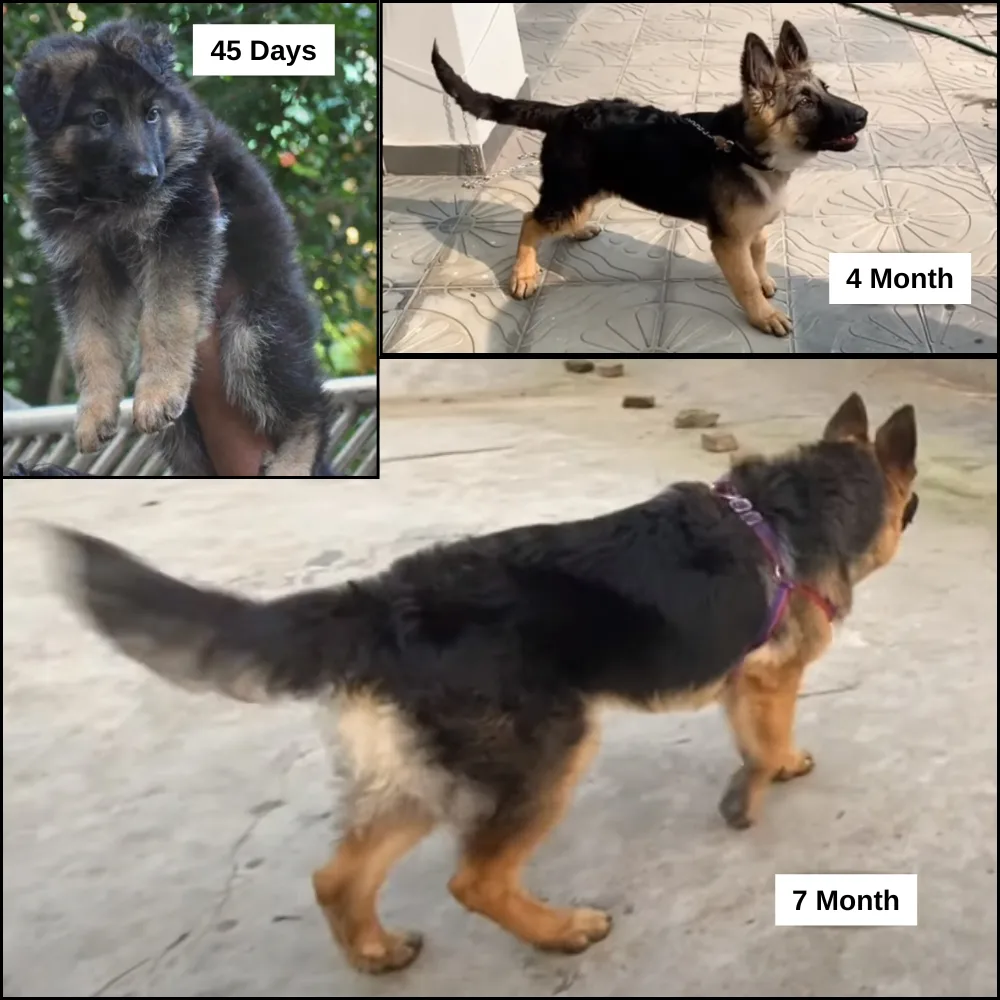
04. How to Determine the Age of a German Shepherd Puppy By Observing Its Behavior
Observing the puppy’s behavior provides additional clues to determine its age.
Very young German Shepherds, around 1-2 weeks old, are mostly sedentary, spend their time sleeping and nursing. They don’t interact much with their surroundings due to their limited vision and hearing.

By the age of 3 weeks, puppies become more interactive, begin to explore their environment, albeit clumsily, indicating their age through increased engagement and the beginning of play behavior.
RELATED: What is the Average Intelligence of German Shepherds?

Around 4 to 5 weeks, German Shepherds start exhibiting more coordinated movements, engaging in more complex play, including light play-biting and chasing, showing they’re getting more comfortable with their physical abilities.

Between 6 to 8 weeks, puppies are more adventurous, their personalities begin to emerge, and they can start learning simple commands, indicating a critical socialization phase.

Observing a puppy’s reactions to unfamiliar objects or situations can also give clues to its age. The puppies older than 8 weeks often show more confidence and curiosity due to their developmental stage.

By 4 to 6 months, a noticeable increase in independence and possibly the beginning of fear periods can help pinpoint this age range.

As German Shepherds transition into adolescence, around 6 to 18 months, you may notice an increase in rebellious behaviors, testing boundaries and potentially challenging commands. This age is crucial for training and socialization to influence their temperament and behavior.
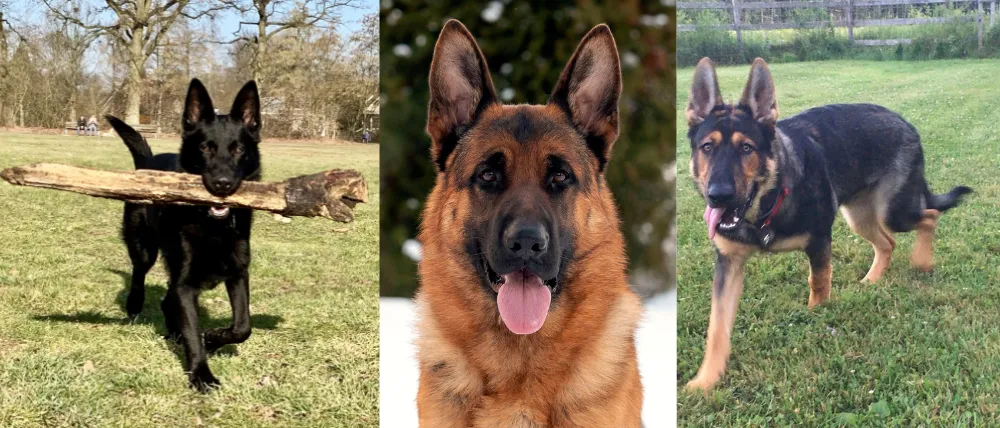
By the time a German Shepherd reaches adulthood, from about 2 to 3 years old, there is a notable shift towards more steadiness and maturity in its behavior.

Aged German Shepherds, those beyond 7 years, could start to show signs of slowing down. Their play might be less vigorous, and they may take more time to rise or show stiffness after resting.

Final Thoughts
We hope that this detailed guide would have helped you to determine the age of a German Shepherd puppy or an adult dog. The first 2 techniques are more authentic and accurate. It’s important to consider that individual dogs may deviate from typical patterns and features due to health, genetics, environment, etc. However, by combining physical examinations and behavioral observations one can estimate a German Shepherd’s age with reasonable accuracy. Consulting a veterinarian can also provide a more accurate age estimate and ensure your puppy is developing correctly.
If you like this post then don’t forget to share with other people. Share your feedback in the comments section below.
Also Read
- Is There a Mini German Shepherd Breed Exist?
- Slant Back German Shepherds | Types of Showline GSDs
- Straight Back German Shepherds | Types of Working Line GSDs
- Are White German Shepherds Purebred?
- How to Extend the Lifespan of German Shepherd




Leave a Reply